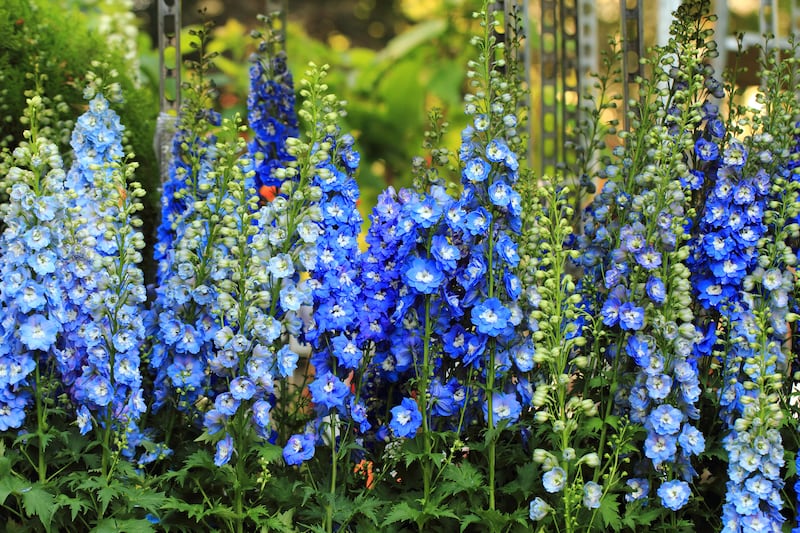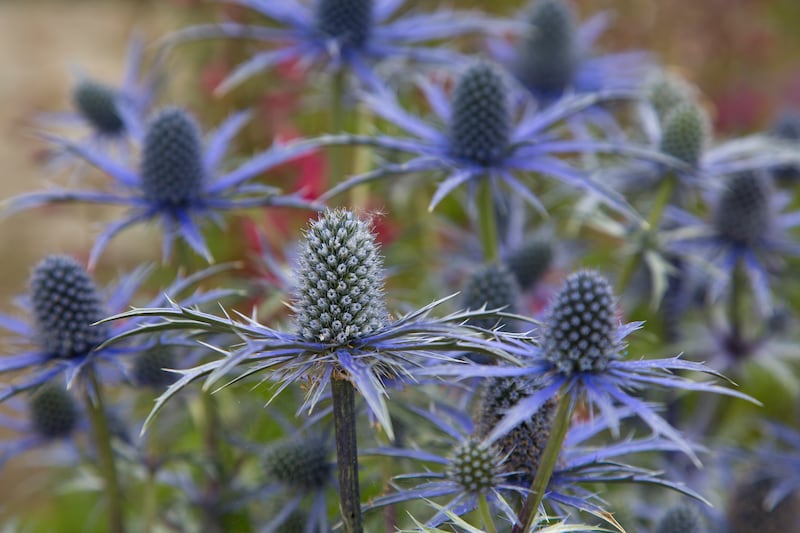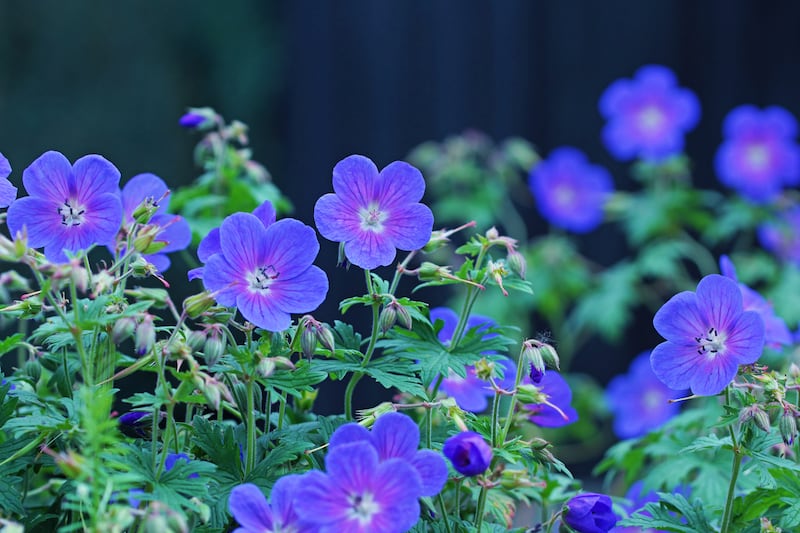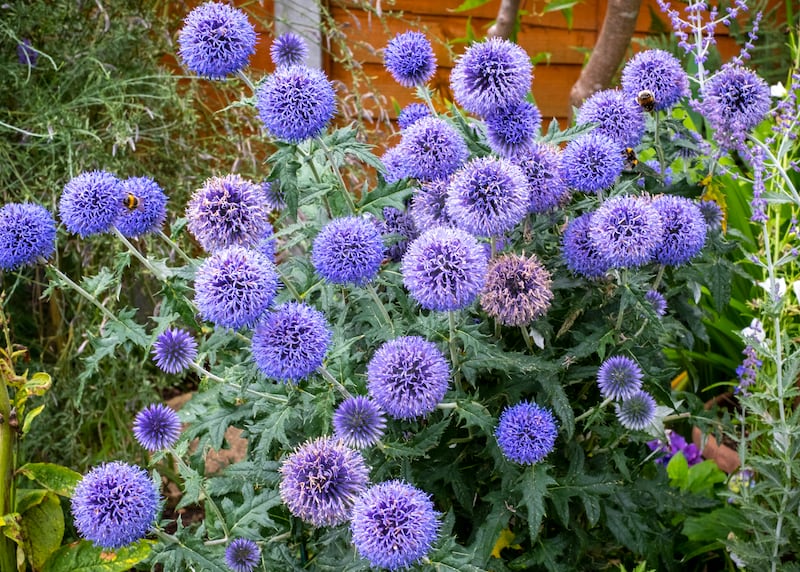As a gardener and flower-farmer-florist, colour fascinates me. Through trial and error, I’ve learned that some hues make natural bedfellows (hello, orange and lime green), while others are decidedly more edgy (for example, pink and red, or pink and yellow). Likewise, there are those colours that never quite make the grade (for example, dirty pinks and acid lemons), while others have a strange ability to magically elevate a planting plan and capture the zeitgeist in a way that’s hard to fathom. This year it’s the turn of blue to play the starring role, something that Pantone predicted with eerie accuracy when it named Very Peri, a violet-infused blue tone, as the colour of the year for 2022.
True blue is relatively rare in the world of flowers, of course, especially in late-summer, when hot colours dominate the garden. But it’s not its rarity that makes it so covetable so much as its ability to add depth, mystery, serenity and an air of sophistication to pretty much any planting combination. Sprinkle cool pops of blue through a hot border filled with electric pinks and shades of sultry orange and something special happens. Mix it through pastels and it stops them being sickly. Thread it through a wild flower meadow and it brings it to life. Not convinced? Add any of the following to your late-summer garden or allotment and see the magic for yourself.
10 blue-flowering plants for the late-summer or early-autumn garden
Delphiniums
Not all delphiniums are blue (some come in shades of lilac, pink and white), but this hardy, stately herbaceous perennial is traditionally known for its tall spires of summer blooms in shades of kingfisher, peacock, gentian and cobalt blue. For a contemporary look, avoid overbred varieties with densely double flowers and instead concentrate on single-flowered varieties, which look more graceful and are better for pollinators. Examples include Delphinium (Belladonna Group) ’Piccolo’ and Delphinium (Belladonna Group) ‘Atlantis’. Delphiniums typically produce their first flush of flowers in early-summer, but if you make sure to deadhead the plants before they set seed, then they’ll produce a second flush around this time of year. Give them a rich, free-draining soil in full sun and protection from slugs in early-spring.

Agapanthus
A great choice for milder parts of the country, this handsome, sun-loving perennial produces clusters of long-lasting starry flowers on tall, slender stems through summer and into autumn. A huge range of excellent, blue-flowered cultivars and varieties are available, some small enough to tuck into a window box, some so large that they’re only suitable for big gardens, some with evergreen foliage and others that are herbaceous. (The latter are typically hardier.) Some of the best include Agapanthus ‘Lilliput’ (compact, herbaceous variety with deep-blue flowers); Agapanthus ‘Northern Star’ (tall, violet-blue flowers, herbaceous) and Agapanthus ‘Blue Storm’ (compact, semi-evergreen, deep-blue flowers). All agapanthus perform best in a rich, moist but free-draining soil where their roots are constricted, making them a great choice for container growing.
I may very well have ignored the call to home if I hadn’t been robbed at knifepoint in Brazil
Oscars 2025 red carpet: A night of Old Hollywood glamour, shimmering silvers and dramatic silhouettes
‘Where I come from, people don’t do medicine. It’s not on your radar’: how a new generation of GPs is being trained
Despite earning €100,000 a year, buying a one-bed apartment in Dublin still seems an impossible dream
Eryngium
Commonly known as sea holly, this hardy, sun-loving perennial features distinctive spiky blue flowers that are one of the glories of the late summer-autumn garden. Outstanding varieties include Eryngium zabelii ‘Big Blue’ (medium height, herbaceous, with large, metallic-blue flowers and silver foliage); Eryngium x oliverianum (tall, herbaceous, silver blue flowers) and Eryngium planum ‘Blue Glitter’ (tall, dark-blue, herbaceous).

Cornflowers
A short-lived hardy annual that’s best direct-sown en masse in autumn or early-spring, cornflowers (Centaurea cyanus) are the quintessential meadow flowers and the stuff of postcards with their dainty, slender-stemmed blooms that are invaluable for adding vivid pinpricks of bright blue. These pretty flowers are also edible (they look lovely sprinkled in a salad or as a garnish), as well as perfect for pressing.
Geraniums
The genus of hardy geraniums or cranesbills contains many excellent blue-flowering varieties that make a brilliant addition to the late-summer garden. Long-flowering, fast-growing, versatile and almost un-killable, these clump-forming herbaceous perennials are the mainstay of many flower borders. Outstanding varieties include Geranium ‘Rozanne’, Geranium ‘Azure Rush’ and Geranium ‘Orion’. To keep them tidy and encourage a continuous display of flowers, regularly cut out any faded stems and leaves.

Salvia
Hardworking, long-flowering and pollinator-friendly, ornamental salvias have grown hugely in popularity in recent years. Blue-flowered varieties that will add a pretty pop of colour to the late summer-autumn garden include the frost-tender Salvia ‘Animo’ (similar in growth habit to the well-known purple-flowering Salvia ‘Amistad’) and Salvia ‘Caradonna’ (a hardy, herbaceous clump-forming perennial with violet-blue flowers throughout summer and early-autumn). Not a true blue but close enough, the sun-loving, deciduous sub-shrub commonly known as Russian sage is also prized for its slender spires of pollinator-friendly lavender-blue flowers, which appear above the aromatic, silver-grey foliage from late-summer into autumn. The go-to variety is Salvia yangii ‘Blue Spire’ (confusingly, this was known as Perovskia atriplicifolia ‘Blue Spire’ until very recently, when taxonomists added it to the sage family), a brilliant choice for a hot, gravel garden or a very free-draining soil in full sun.
Echinops
Another star of the late-summer/early-autumn flower garden, the sun-loving globe thistle is a resilient, hardy perennial that can cope with almost every kind of soil bar a sodden one. Its distinctive globe-shaped, silver-blue, long-lasting flowers appear on tall, stiff silver-white stems in late-summer and add both structure and glitter to a planting scheme. Pollinators adore them while it also makes a great cut-flower. Well known varieties include Echinops ritro ‘Veitch’s Blue’ and Echinops bannaticus ‘Blue Globe’.

Nigella
Another short-lived but easy-to-grow hardy annual that’s great for sprinkling through a sunny border, Nigella, or love-in-a-mist, as it’s commonly known, is best sowd directly in autumn or early-spring. Give it a free-draining, not overly fertile soil in full sun and it will often self-seed generously from then on. Well-known varieties include the sky-blue Nigella damascena ‘Miss Jekyll Blue’ and the dark-blue Nigella hispanica. Both will flower through summer into autumn and make very pretty cut-flowers.
Aconitum
Commonly known as monkshood, and similar to delphiniums in appearance but easier to grow and later-flowering, these tall, clump-forming perennials are a mainstay of the late summer — autumn flower garden. Outstanding varieties include the silver-blue flowering Aconitum ‘Stainless Steel’, the midnight-blue flowering Aconitum ‘Spark’s Variety’, the lavender-blue ‘Kelmscott’ and the lilac-blue Aconitum carmichaelii ‘Arendsii’. Bear in mind that all parts of the plant, which is also known as wolfsbane, are poisonous. Monkshood likes a cool, rich, moisture-retentive soil.
Clematis
Some of the late-flowering clematis are brilliant for bringing their own special brand of beauty to the garden at this time of year, including the newly introduced, Japanese-bred Clematis ‘Fukuzono’ (violet-blue flowers from July to September), the nonclimbing Clematis diversifolia ‘Petit Faucon’ (lavender-blue flowers from July to September), the nonclimbing, very long-blooming Clematis integrifolia ‘Twinkle’ (pale-blue flowers from June to September) and Clematis tubulosa ‘Wyevale’ (pale-blue flowers from July to October). Give these hardy plants a sheltered position, where their roots are shaded from direct sun, and a moist but free-draining, fertile soil. Many of the above will also do very well grown in a large container.
This Week in the Garden
To ensure that container-grown camellias and rhododendrons will flower freely next year, it’s very important to keep them regularly watered, to prevent the root systems from ever drying out and to give them a potash-rich liquid feed to encourage the initial formation of flower buds, something the plants start to do at this time of year.
August is a great time of year to sow seed of winter salad crops, including rocket, pak choi, corn salad, mizuna, tatsoi, claytonia and mustard. Recommended seed suppliers include all good garden centres as well as specialist online Irish suppliers such as greenvegetableseeds.com, brownenvelopeseeds.com and seedaholic.com.
Dates for Your Diary
On August 6th from 1.30pm, June Blake’s garden’s new indoor plant, lifestyle and coffee shop, Epoch Green, at Tinode, near Blessington, Co Wicklow is hosting an outdoor party with live music.
Also continuing in the garden throughout August, A Month of Dahlias celebrates this beautiful and diverse genus of summer and autumn flowering plants with a talk/guided tour by June every Sunday throughout the month at 2pm. Throughout August, Patthana Garden in Kiltegan, Co Wicklow is celebrating Full Bloom August with a walk and talk in the garden by owner and creator TJ Maher, every Sunday at 2pm, with teas and home-made cakes served all afternoon.
















